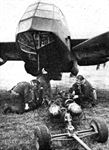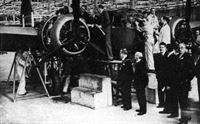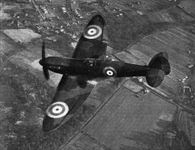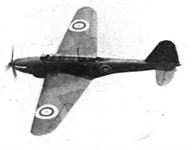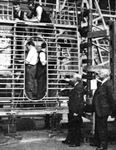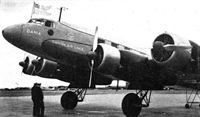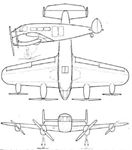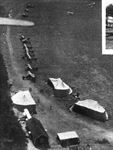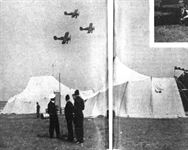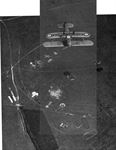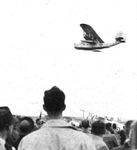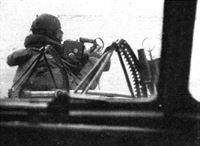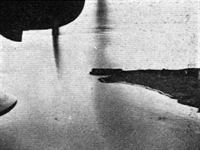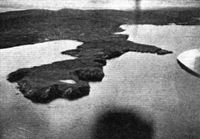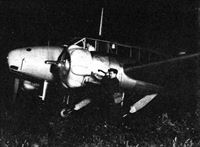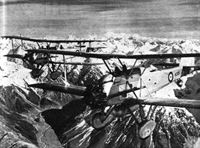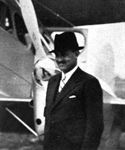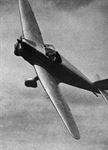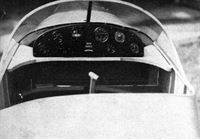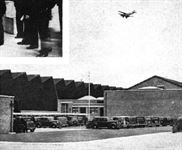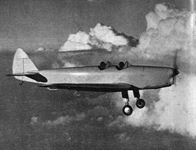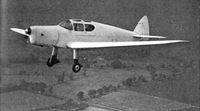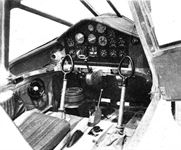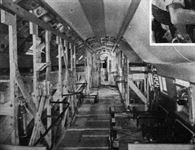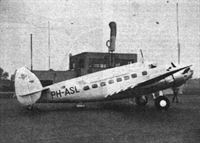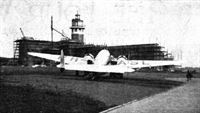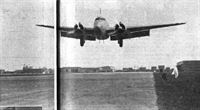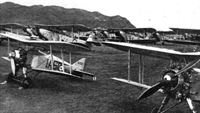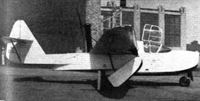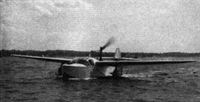Фотографии
-
BOMBING-UP a Blenheim during the Air Exercises. It will be noted that bombs now travel in comfort all the way.
Самолёты на фотографии: Bristol Blenheim - Великобритания - 1936
-
A shadow taking form. The Air Minister inspecting the building of a Bristol Blenheim at the new factory at Speke. On the left, he is seen between the two brothers Rootes.
Самолёты на фотографии: Bristol Blenheim - Великобритания - 1936
-
TRAPEZOIDAL: The unusual plan form of the Handley Page Hampden is well brought out in this picture. The machine is now in large-scale production at Cricklewood, where, the makers claim, the new system will “result in a peak rate of production at least twice that of the Harrow for the same floor space.”
Самолёты на фотографии: Handley Page Hampden / H.P.52 - Великобритания - 1936
-
TRICYCLE HURRICANE: An amusing snap at Northolt when the Hurricanes of No. 111 (F.) Squadron were taking off for their recent Paris visit.
Самолёты на фотографии: Hawker Hurricane - Великобритания - 1935
-
FIGHTER CAMOUFLAGE. The Supermarine Spitfire (Rolls-Royce Merlin engine) is quite difficult to see against the ground. Now being produced in quantities for the R.A.F., the Spitfire has also been ordered from Lord Nuffield, who is to build it in his new Birmingham factory.
Самолёты на фотографии: Supermarine Spitfire - Великобритания - 1936
-
Самолёты на фотографии: Fairey Battle - Великобритания - 1936
-
Sir Kingsley Wood and Lord Austin watch the assembly of a centre section in a vertical jig.
Самолёты на фотографии: Fairey Battle - Великобритания - 1936
-
Sir Kingsley and Lord Austin with - on the left - Sqn. Ldr. T. H. England, who demonstrated the machine.
Самолёты на фотографии: Fairey Battle - Великобритания - 1936
-
Регистрационный номер: G-ADHJ, G-ADHK ATLANTIC SPIRIT: The Shell tender at Foynes ministering to Mercury and Maia before the historic Atlantic flight.
Самолёты на фотографии: Short Mayo Composite (S.20 Mercury and S.21 Maia) - Великобритания - 1938
-
HART VERSUS VULTURE: A reader in India sends the above photographs. They show the damage done to a Hawker Hart of No. 11 (Bomber) Squadron, stationed at Risalpur, which struck a vulture while making a circuit before landing. The bird hit the starboard top main plane as shown in the left-hand view and the remains passed back under the wing, striking and bending a landing wire so that it had to be replaced. Half of the bird remained there and the rest struck the tail plane as shown on the right. These vultures normally have a span of about 6ft. and weigh between 20 and 30 lb.
Самолёты на фотографии: Hawker Hart - Великобритания - 1928
-
Второй прототип PZL P.37/II (№ 72.2) во время испытаний в конце 1937 года. Самолет заменил собой первый прототип, разбившийся 20 июня 1938 года, и имел ряд отличий, включая новые двигатели Bristol Pegasus XX, двухкилевое хвостовое оперение и новое шасси.
POLISH POLISH, 1938: The new P. Z. L. P37 high-performance bomber is one of the latest additions to European military types. Its performance is comparable with the Bristol Blenheim. The wings, including the covering, are of metal construction. Slotted flaps, complete with recessed king-posts and hinges, extend from the fuselage to the ailerons. The leading edges are slotted from the wing-tips to the engine nacelles.Самолёты на фотографии: PZL P.37 Los - Польша - 1936
-
Регистрационный номер: D-ACON [2], D-AERE [2] Heroes of the moment, the crew of the Brandenburg prepare to face a typical Berlin welcome. Capt. A. Henke leads his co-pilot, Flt./Capt. von Moreau, down the steps. They are followed by the mechanic, Dierberg, and W/O Kober.
Самолёты на фотографии: Focke-Wulf FW.200 Condor - Германия - 1937
-
Регистрационный номер: OY-DAM, DX177, G-AGAY DENMARK'S BIGGEST: On Thursday of last week D.D.L.'s first Focke-Wulf Condor was brought over to Croydon by way of an introduction to its use on the regular Copenhagen-London run. This is the first time that the attractive Danish flag has been flown from a commercial machine at Croydon.
Самолёты на фотографии: Focke-Wulf FW.200 Condor - Германия - 1937
-
Регистрационный номер: D-ACON [2], D-AERE [2] Совершивший в 1938 году эпические трансатлантические перелеты, самолет Brandenburg окружен толпой публики и репортеров в берлинском аэропорту Темплхоф.
In spite of a heavy downpour, a vast crowd waited at Templhof, Berlin, to give the Focke-Wulf Condor, Brandenburg, a tumultuous welcome on its return from New York in under twenty hours. On the outward journey it covered the 3,970 miles in 24 hr. 56 min.Самолёты на фотографии: Focke-Wulf FW.200 Condor - Германия - 1937
-
Регистрационный номер: L4537 Some of the C.F.S. instructors. Names, left to right, are : Flt. Lt. P. A. Hunter, Flt. Lt. H. W. Marlow, Flt. Lt. P. E. Drew, Flt. Lt. J. S. McLean, Flt. Sgt. D. A. Upton, Flt. Lt. F.D. Stephenson, Flt. Lt. R. L. Wilkinson, Sqn. Ldr. D. D’Arcy Greig, D.F.C., A.F.C. (Chief Flying Instructor), Sgt. J. C. Wheeler, Flt. Lt. F. W. C. Shute, Flt. Sgt. R. W. Jarred, Flt. Sgt. A. R. Glading, Flt. Lt. H. W. Mermagen, Flt. Sgt. J. O. Barnes, Flt. Lt. P. S. Salter, Flt. Sgt. R. E. Kirlew, Flt. Sgt. T. A. Newton, Flt. Sgt. S. J. Mansell, Flt. Sgt. P. C. Price, Flt. Sgt. W. Corden, Flt. Sgt. L. F. Humphrey.
Самолёты на фотографии: Airspeed Oxford / AS.10 - Великобритания - 1937
-
Регистрационный номер: X13262 Fig 8. The Crouch-Bolas biplane in a typical landing attitude.
In its final configuration Dragonfly X13262 taking off from Colonel Green's private flying field at Round Hill, Massachusets, circa 1934.Самолёты на фотографии: Crouch-Bolas Dragonfly - США - 1934
-
Landing approach oi the Crouch-Bolas biplane and a conventional biplane. The sketches are accurate copies of an actual film.
Самолёты на фотографии: Crouch-Bolas Dragonfly - США - 1934
-
Stages in the take-off of the Crouch-Bolas biplane and an orthodox machine. Sketches prepared from a film.
Самолёты на фотографии: Crouch-Bolas Dragonfly - США - 1934
-
The design of the Crouch-Bolas Speed-Ranger indicates that little departure from conventionality need be incurred to obtain the full effect of the tilted slipstream arrangement.
Самолёты на фотографии: Crouch-Bolas Dragonfly - США - 1934
-
An aerial view of the Gloster Gladiators at Rinkaby armament training camp, South Sweden.
Самолёты на фотографии: Gloster Gladiator - Великобритания - 1934
-
With this picture, our photographer wins the low-altitude aerial competition. The wheels of his machine touched the ground as the photograph was taken, hence the slightly blurred image.
Самолёты на фотографии: Gloster Gladiator - Великобритания - 1934
-
One of the Bristol Mercury engines is being supplied with “flygbenzin.”
Самолёты на фотографии: Gloster Gladiator - Великобритания - 1934
-
Three of the machines off to practise flight aerobatics.
Самолёты на фотографии: Gloster Gladiator - Великобритания - 1934
-
Some Swedish Flight Cadets of the “Svea” Fighter Wing, with their officers, Sqn. Ldr. Bang, Flt. Lt. Uggle, Flt. Lt. Lambert and Flt. Lt. Norm.
Самолёты на фотографии: Gloster Gladiator - Великобритания - 1934
-
Регистрационный номер: K8238 This is not (as the poet has it) “a woman scorned,” but a very deliberately upset Fury, flown by a C.F.S. instructor. Past days at Hendon showed the almost uncanny skill of C.F.S. instructors in inverted aircraft.
The real thing. A CFS instructor inverts Hawker Fury K8238 near Upavon for the benefit of Flight’s photographer, August 1938.Самолёты на фотографии: Hawker Fury - Великобритания - 1931
-
The crowd in the official enclosure with a background of Gauntlets. The rest of the ten thousand are out of the picture to the right. Some idea of the conditions will be gathered from the fact that the clouds were sometimes touching the low hills seen in the distance.
Самолёты на фотографии: Gloster Gauntlet - Великобритания - 1929
-
The Saro London distracts attention from the ceremonial proceedings as it scrapes along below the cloud base to open the flying display.
Самолёты на фотографии: Saunders-Roe London / A.27 - Великобритания - 1934
-
The navigator in a London of No. 201 Sqn. uses his camera from the forward gun position. The photograph was taken over Montrose from the second pilot’s seat during the recent manoeuvres. A new form of suiting having “built-in” silk harness and floatation equipment, including a small sparklet-type compressed air bottle is used by the Squadron.
Самолёты на фотографии: Saunders-Roe London / A.27 - Великобритания - 1934
-
Off the coast of Shetland. Off the east coast shoals of herring were seen, but no fishing fleet.
Самолёты на фотографии: Short Sunderland / S.25 - Великобритания - 1937
-
A long way from Land’s End. “Across the Pentland Firth we spied John o’ Groats.”
Самолёты на фотографии: Short Sunderland / S.25 - Великобритания - 1937
-
One of the first glimpses of land when returning from the coast of Norway was this one of No Ness, Shetland.
Самолёты на фотографии: Short Sunderland / S.25 - Великобритания - 1937
-
The Short Sunderland at moorings on the waters of the Cromarty Firth, off Invergordon.
Самолёты на фотографии: Short Sunderland / S.25 - Великобритания - 1937
-
DAWN PATROL: A G.R. Anson being started up at 03.00 hours during the recent Coast Defence Exercises.
Самолёты на фотографии: Avro Anson / Type 652 - Великобритания - 1935
-
Регистрационный номер: NZ105 PUTTING THEIR TRUST IN PEGASUS: Vickers Vildebeestes of the Royal New Zealand Air Force flying at 13,000ft. over no sort of country for forced landings. The scene is the Southern Alps of New Zealand and the temperature, according to the photographer, was to deg. below zero. Beneath the nearest machine is a long-range tank.
Самолёты на фотографии: Vickers Vildebeest / Type 132 - Великобритания - 1928
-
Регистрационный номер: G-ADAI, G-ADIM The Martin Navigation fleet consists of three D.H. Rapides and a Dragon
Самолёты на фотографии: De Havilland Dragon Rapide / Dominie / D.H.89 - Великобритания - 1934
-
MAJOR D. CLOETE, M.C., A.F.C., Director of Aviation in the Government of Southern Rhodesia, with the D.H.89 which he is flying out to Africa. At a ceremony at Hatfield recently, Mrs. Lanigan-O’Keefe, wife of the South Rhodesian High Commissioner in London, named the machine Southern Rhodesia. Used on administrative duties, it will save officials many long and tedious journeys. Maj. Cloete, who was flying in 1914-1918, and was a C.F.S. pilot, will pilot the D.H.89 on many of these trips.
Самолёты на фотографии: De Havilland Dragon Rapide / Dominie / D.H.89 - Великобритания - 1934
-
The School machines are conventionally equipped in the matter of wireless, though one of them (shown) has its own D/F loop. At the rear of the cabin there is a tail drift sight and a bearing compass.
Самолёты на фотографии: De Havilland Dragon Rapide / Dominie / D.H.89 - Великобритания - 1934
-
One of the pupils at work at the chart table while the machine is over the Channel on an instructional trip.
Самолёты на фотографии: De Havilland Dragon Rapide / Dominie / D.H.89 - Великобритания - 1934
-
A twin-engined Focke-Wulf is used exclusively for a new aerial survey of the whole of Sweden. The machine is completely equipped for aerial photography.
Самолёты на фотографии: Focke-Wulf FW.58 Weihe - Германия - 1935
-
The general layout of the Tipsy two-seater is admirably shown in this photograph. The extensive and draught-free windscreen arrangement is noteworthy. For this and the other pictures the machine was flown by Flt. Lt. Staniland, the chief test pilot of the Fairey Aviation Company.
Самолёты на фотографии: Tipsy B / BC - Бельгия - 1937
-
Регистрационный номер: G-AFGF This three-quarter-rear view shows both the tail design with one-piece elevator, and the very small ground angle which, coupled with a limited elevator movement, gives something of a tricycle ease to the business of landing the machine.
Самолёты на фотографии: Tipsy B / BC - Бельгия - 1937
-
The preliminary instrument layout. In later models the vertical-reading compass will be replaced by the normal type, which will be mounted below the dashboard, and its place will be taken by a turn indicator. When used for dual instruction the centrally disposed control column is fitted with a “tiller ” extension for the instructor on the right
Самолёты на фотографии: Tipsy B / BC - Бельгия - 1937
-
The Air Council’s D.H.86 arriving over the factory.
Самолёты на фотографии: De Havilland Express Air Liner / D.H.86 - Великобритания - 1934
-
Arrived at Ards Aerodrome. In this group are, from left to right, Flt. Lt. Lee, Sqn. Ldr. Goode, Lord Londonderry, Sir Edward Campbell, Sir Kingsley Wood, and Lord Craigavon.
Самолёты на фотографии: De Havilland Express Air Liner / D.H.86 - Великобритания - 1934
-
C.A.G. PROTOTYPE: The open-cockpit version of the new D.H. Moth Minor. Its form will be familiar to regular Hatfield visitors, since this and a cabin version has been in and out of the air for the past year. From its inception the D.H.94 has been the special interest of Capt. Geoffrey de Havilland himself, and, with the Air Guard scheme in action, it will now have its chance.
Самолёты на фотографии: De Havilland Moth Minor / D.H.94 - Великобритания - 1937
-
CABIN VERSION: The new Moth Minor, which should be in production early next year, in its cabin form. It is a tandem-seater in which the pilot sits ahead, with a really good view forwards and over the leading edge.
Самолёты на фотографии: De Havilland Moth Minor / D.H.94 - Великобритания - 1937
-
Самолёты на фотографии: Percival Vega Gull / K.1 - Великобритания - 1935
-
Регистрационный номер: D-AJEY D.L.H. ATLANTIC PROGRESS: The D.L.H. Blohm and Voss, Ha.139, Nordmeer, flew on Monday of last week from the Azores to Port Washington, Long Island, in under 17 hours. Here is seen a sister-ship, Nordwind. An improved version built for the Azores-New York service is the Ha.139B, the first example of which is named Nordstern. Still using Jumo 205 Diesels, the cruising speed has been increased to 270 km./hr. (168 m.p.h.) and the range to 5,200 km. (3,200 miles).
Самолёты на фотографии: Blohm und Voss Ha.139 - Германия - 1936
-
Регистрационный номер: NX18100 [2] An artificial vibration machine, the period of which can be varied to suit the component being tested.
Самолёты на фотографии: Douglas DC-4E - США - 1938
-
Регистрационный номер: NX18100 [2] From the photograph one obtains an idea of the elaborate timber framework installed to carry the pig lead used in the load-distribution flight tests.
Самолёты на фотографии: Douglas DC-4E - США - 1938
-
Регистрационный номер: PH-ASL [3] Three-Fifty-Five (Amsterdam time): The Lockheed 14 ready to load up for the Liverpool run. The signboard on the right tells both passengers and public all about it.
Самолёты на фотографии: Lockheed Super Electra 14 - США - 1937
-
Регистрационный номер: PH-ASL [3] Fifteen minutes at Doncaster: The Lockheed in front of the control building, on which the D.F. loop may be seen. When this photograph was taken the last was not being a great deal of use since the whole district was suffering from a series of violent thunderstorms.
Самолёты на фотографии: Lockheed Super Electra 14 - США - 1937
-
Регистрационный номер: PH-ASL [3] TERMINAL: A K.L.M. Lockheed 14 Refuelling at the back of the shortly-to-be-completed airport building at Speke, Liverpool. For a long time the control tower stood alone in its glory; the rest of the building now begins to give it true perspective.
Самолёты на фотографии: Lockheed Super Electra 14 - США - 1937
-
The photograph of the Lockheed coming in to land on one of Schiphol’s runways, which are now being further extended, gives a good idea of the area presented by the Fowler flaps. The cleanliness of the retractable undercarriage is noteworthy.
Самолёты на фотографии: Lockheed Super Electra 14 - США - 1937
-
Inside the control cabin of the Fourteen: The main control bank appears to be more complicated than it really is in practice. At its base, with appropriate indicators, can be seen the tab trimmer cranks for the elevators, rudder and ailerons, with the pull-type brake lever in the centre. Above are the engine, airscrew, heater, boost and automatic pilot controls. The flying instruments are on the left of the Sperry panel, and the temperature and fuel gauges on the right. At the top of the board will be seen the boost gauges (all-important nowadays) and the two-needle revolution indicators.
Самолёты на фотографии: Lockheed Super Electra 14 - США - 1937
-
Inside the cabin of one of the K.L.M. Lockheeds. The radio operator is seated in front on the right; part of his equipment may be seen. British Airways’ Fourteens will have a separate compartment for the operator. The passengers’ seats are normally adjustable and may also be turned.
Самолёты на фотографии: Lockheed Super Electra 14 - США - 1937
-
Very pretty formation: The leading Cadet was flown by one of the instructors, but all the other eight were piloted by members of the squadron.
Самолёты на фотографии: Avro Cadet / Type 631/643 - Великобритания - 1932
-
Регистрационный номер: G-ACNF, G-ADAV Самолёты на фотографии: Avro Cadet / Type 631/643 - Великобритания - 1932
-
A TWIN-ENGINED ALTAIR: Yes, really. The power plant consists of two inverted Menascos geared to one airscrew. Either engine may be taken out of gear if trouble occurs. The machine has been constructed by the Vega Airplane Company, a Lockheed subsidiary.
Самолёты на фотографии: Lockheed Sirius / Altair 8 - США - 1929
-
Самолёты на фотографии: Lockheed Sirius / Altair 8 - США - 1929
-
HARKING BACK IN NEW ZEALAND: Some old-timers still in service with the Royal New Zealand Air Force lined up for inspection by the Governor-General, Lord Galway, at Rongotai Aerodrome. The pretty little fighters in the foreground are Gloster Grebes (circa 1928) and behind are Blackburn Baffins.
Самолёты на фотографии: Blackburn Baffin / B-5 - Великобритания - 1933Gloster Grebe - Великобритания - 1923
-
EVOLUTION: Developed from the Amiot 370, holder of several world’s speed-with-load records, the Amiot 340 bomber has been ordered in large numbers for the French Air Force. The prototype 370 had liquid-cooled Hispano 127 engines giving a maximum speed of 305 m.p.h. at 16,400ft. The 340 bomber has more powerful two-row Gnome-Rhone radials. On the record machine the pilot looked forward through the transparent nose portion, the fuselage form being uninterrupted, but in the production bomber a projecting cockpit enclosure is fitted. The span is 75ft. 6in.
Самолёты на фотографии: Amiot Amiot 370 - Франция - 1937
-
AMPHIBIOUS UNORTHODOXY: The Spencer-Larsen S.L.-12C, which has a four-cylinder Menasco in the hull driving a pusher propeller through gear transmission. Two main wheels of the tricycle undercarriage are mounted in the tails of the floats and retract with the floats. Constiuction is mainly of wood. Data are: span, 40ft.; wing area 164 sq. ft.; weight empty, 1,600 lb.; and gross weight, 2,200 lb.
Самолёты на фотографии: Spencer-Larsen SL-12C - США - 1938
-
Самолёты на фотографии: Spencer-Larsen SL-12C - США - 1938
Статьи
- Flight
- Flight Advertisements
